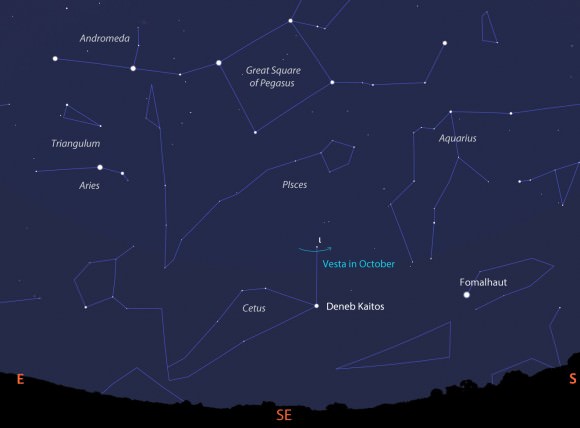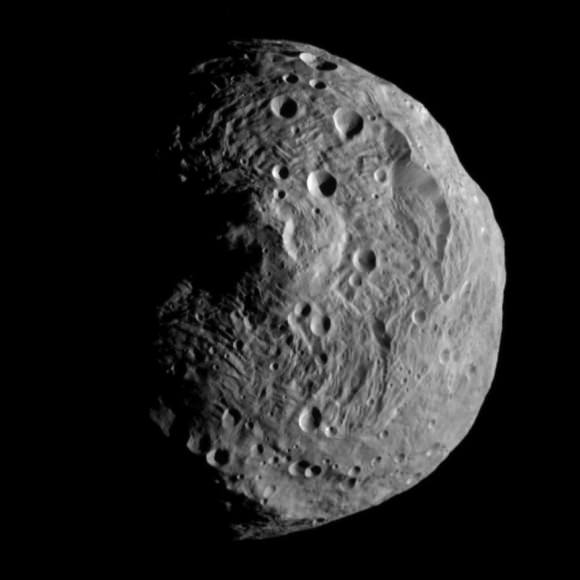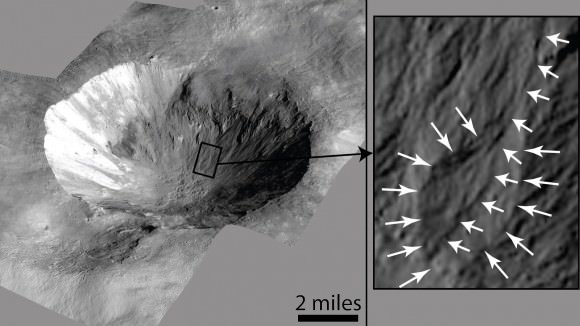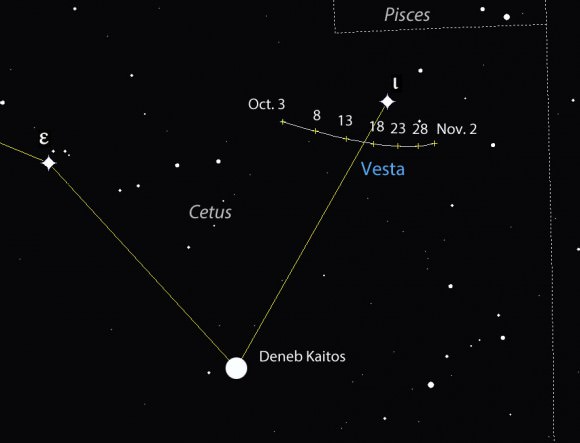The brightest asteroid visible from Earth prowls across Cetus the Whale this month. Vesta shines at magnitude +6.3, right at the naked eye limit for observers with pristine skies, but easily coaxed into view with any pair of binoculars. With the moon now gone from the evening sky, you can start your search tonight.

Vesta came to opposition on September 28 and remains well-placed for viewing through early winter. Today’s it’s 134 million miles (225 million km) from Earth or about 5 million miles farther the Mars’ average distance from us. Although it’s one of the largest asteroids in the inner asteroid belt between Mars and Jupiter with a diameter of 326 miles (525 km), it never appears larger than a point of light even in many professional telescopes. Your binocular view will be as satisfying as the one through Mt. Palomar.

Discovered by the German astronomer Heinrich Olbers in March 1807, Vesta was named for the Roman goddess of home and hearth. NASA’s Dawn spacecraft, currently in orbit around another asteroid, Ceres, visited Vesta between July 2011 and September 2012, taking thousands of close-up images and measuring the mineral make-up of its soil and crust. We learned a few things while we were there:
- Vesta is differentiated into crust, mantle and core just like the bigger planets are. That’s why you’ll sometimes hear it described as a “protoplanet”, the first of its kind discovered in our solar system.
- A class of igneous meteorites fallen to Earth called Howardites, eucrites and diogenites (HED-meteorites) were confirmed as actual pieces of the asteroid that found their way here after being blasted into space by impact.
- Some of the meteorites / rocks that pelted the asteroid from elsewhere in the solar system are water-rich.
- Vesta’s covered in craters like the moon
- A staggering-large 310-mile-wide (500 km) impact crater named Rheasilvia marks its south pole. The basin’s central peak rises to 14.3 miles (23 km), more than twice the height of Mt. Everest.
- Gullies found on its surface suggest ancient water flows.

You can see it all in your mind’s eye the next clear night. For skywatchers at mid-northern latitudes, Vesta climbs into good view around 10 o’clock in early October and 8 o’clock by month’s end. If you’re familiar with gangly Cetus, you can start with the 2nd magnitude star Deneb Kaitos, the brightest star in the constellation. If not, begin your Vestan voyage from the Great Square in Pegasus, high in the southeastern sky.

Drop a line through the two stars along the left side of the Square and continue it down toward the southern horizon. You’ll run right into DK. Now elevate your gaze — or aim your binoculars — one outstretched fist (10°) or about two binocular fields of view above and right of Deneb Kaitos to find Iota Ceti (mag. 3.6).
Once you’ve got Iota, the asteroid will be in your field of view close by. Use the detailed chart to pinpoint its location with respect to Iota. Easy, right? Well, I hope so. Bon voyage to Vesta!


Thank You Bob for the heads up.
We better invest before some low-life, downward looking hedge fund manager grabs the rights and jacks up the price of observing the sky by 5000% …
😉
You’re welcome BC. BTW, thanks for sending your Danjon estimate.